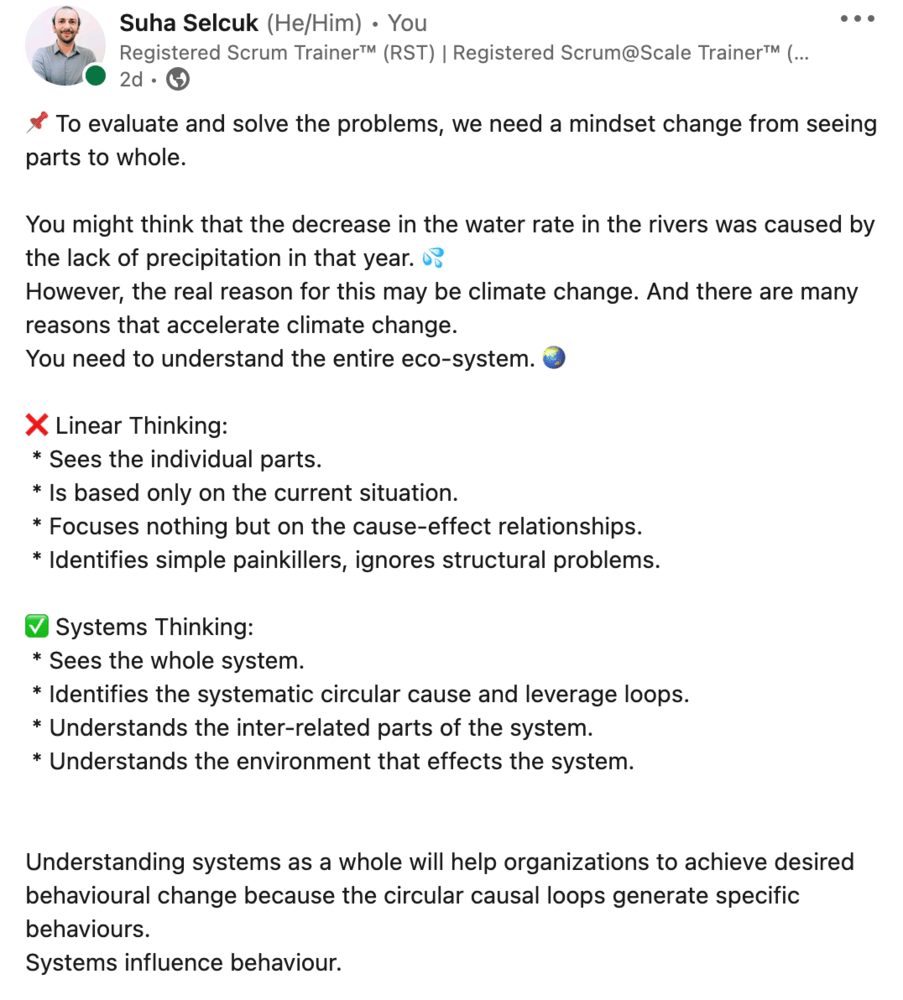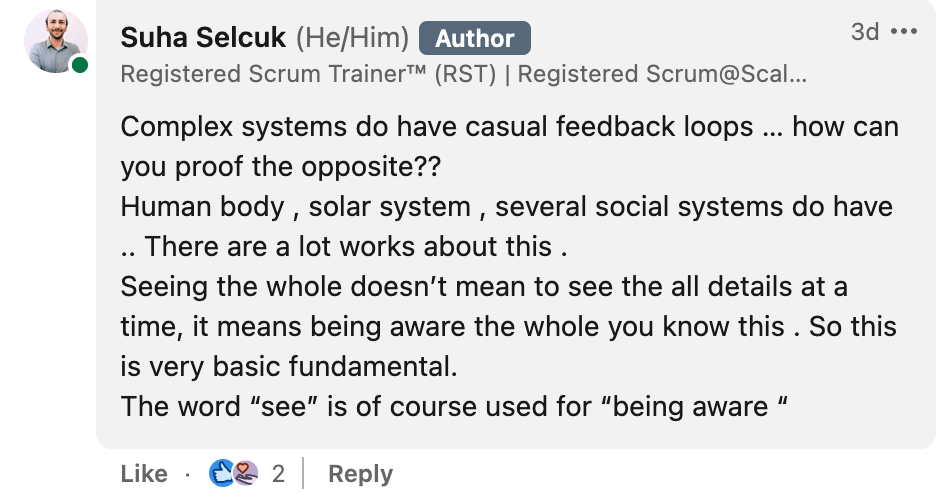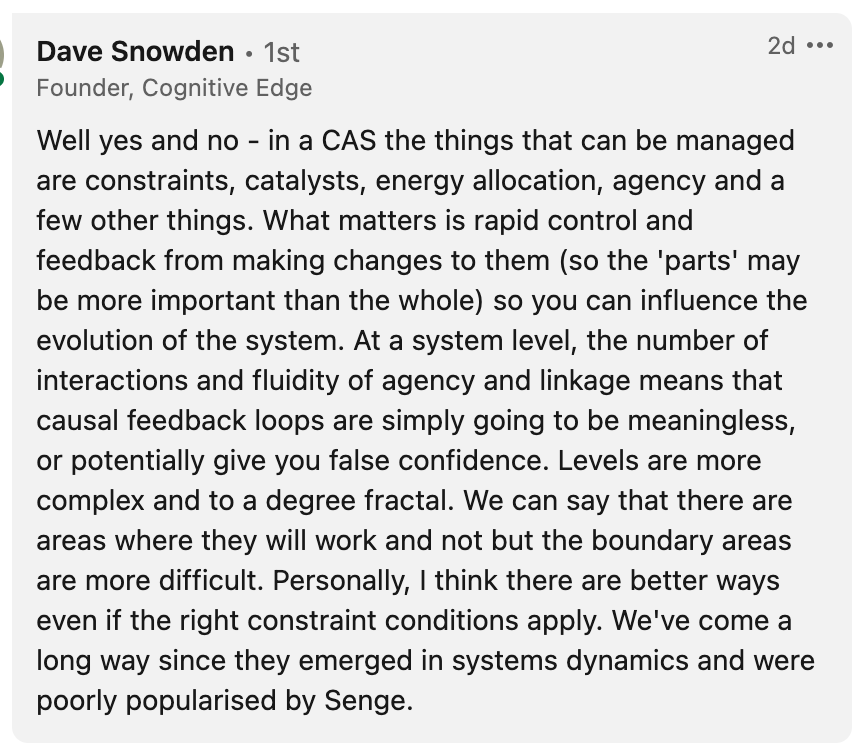My Response to Criticisms About My Linkedin Post
This blog post contains my responses to the theoretical discussions and criticisms within the comments to my Linkedin post below. I will try to explain the context of the post and theoretical background of the discussion.
https://www.linkedin.com/feed/update/urn:li:activity:6946528724032892928/

My intent was not to initiate a theoretical discussion. And it is impossible to give all the details of a theory with a social media post. My aim was to make people query about their rough approach to problems and to introduce the very basics of systems thinking.
I gave a sample about high-level approach for evaluating any problem. Here it is :
“You might think that the decrease in the water rate in the rivers was caused by the lack of precipitation in that year.
However, the real reason for this may be climate change. And there are many reasons that accelerate climate change.
You need to understand the entire eco-system. “
And I tried to underline that focusing nothing but only on the cause-effect relationships, ignoring underlying structural effects, considering only the current situation may have only a limited effect on any problem. Instead if we want to have a real impact on the root causes of the problem we need to consider the whole, identify the systematic circular relations, inter-related parts and understand the environment that affects the whole.
And perhaps this sentence of my post created a confusion:
“Linear Thinking:
* Sees the individual parts.”
Under the Linear Thinking title, the meaning of the phrase “seeing individual parts” is to focus only on the individual event and ignoring the whole. May be it would be better to use “situation” or “event” rather than using the word “part”.
The linear thinking (as I called in my post) reflects the traditional approach to problem solving, focusing only to the current event without considering the system and its inter-related parts.
Let me try to be more clear on that.
“The systems perspective tells us that we must look beyond individual mistakes or bad luck to understand important problems. We must look beyond personalities and events. We must look into the underlying structures which shape individual actions and create the conditions where types of events become likely.” (Senge. P. M. (1990), The Fifth Discipline The Art And Practice Of The Learning Organization. Currency Doubieday.)
Traditional thinking deals only with the problems and tries to find solutions for them. Generally the traditional management approach does not realize that the decisions that are made to solve problems affect each other and the system as a whole. On the other hand systems thinking evaluates the problems as symptoms which have an underlying systematic structural reasons.
“The core aspects of systems thinking are gaining a bigger picture (going up a level of abstraction) and appreciating other people’s perspectives” (Chapman 2004, p. 14)
If you evaluate any case by considering only just one individual event of a system, without considering the whole and the relations of the inter-related parts then you will make incorrect inferences.
Every system (every organization) is a whole, which is the sum of the parts necessary to operate by evaluating the energy (information) coming from the environment. And while fulfilling this function, it exists as long as it can. Because, existing means being able to create a reaction against the environment by evaluating and processing the effects within itself in order to adapt to it. Every specific form (system) of formation of energy (information) consists of organization formed in order to create a reaction against external influences. The reason for existing as an organization is that it is possible to create a response -which is necessary for maintaining its existence- can be achieved only by an organized structure. Because, simply an organized structure can have the necessary information to evaluate the effects of the environment and create a reaction against them. Information is, in all cases, recorded by the relations between parts of an organization.
Rather than looking only at the disjointed parts, systems theory uses a holistic perspective to understand how the parts fit together. These parts are the subsystems. The subsystems affect each other. This means that cause-effect relationships in a system are cyclical and the consequences of an event can also be the cause of the same event. Each subsystem that makes up the whole, is an organ specialized in a particular job to process information coming from outside, using the knowledge within itself. These organs are composed of elements that are specialized in performing a certain task within themselves. While the output of an organ is the result of the organized collective activities of all these elements, the collective activities of the organs (parts) constitute the output of the whole system. Organization within an organization! This is the secret of universal existence!
All the real systems are open systems because they exchange information with the environment. There can never be an absolutely closed system. So there cannot be a real system that exists as a “thing-in-itself” – an “objective absolute reality” – without interacting with the environment.
This approach reveals from its own perspective how to evaluate all kinds of problems by taking into account what needs to be done to solve a problem, which internal and external factors should be taken into account with the emergence of the problem, the effects of the relations between the components on the problem. The most important learning from the circularity of cause-effect relationship in a system is that you can’t always get the result you want by getting rid of the things you don’t want .
Here we need to talk about analyzing Sub-systems. Since it created a lot confusion within the comments of my post.
Actually there can be different ways to analyze subsystems:
- Holistic Analyze – Analyzing entire the system as a functioning whole and then understanding or evaluating the subsystem within it.
- Functionalist approach – evaluation of the role/function of the subsystem fulfills within the system
- Reductionist approach – Reverse of the functionalist approach – analysis the subsystems.
So in my post I used the term “Linear thinking” and this usage doesn’t show that I ignore the reductionist approach to analyze the inter-related parts of the system. And also on the right side under the Systems Thinking column I expressed the sub-systems as “Understands the inter-related parts of the system.” Whenever people see the words, “Linear” and “Part” they thought that I ignore to consider relations between the subsystems. Of course it was not my intent and before posting I didn’t think that people will take it like this.
Beer described his model as “a holistic model involving the complex interactions of five iden
What was the theoretical basis for my post?
The first known systems theory was put forward by the German philosopher Hegel at the beginning of the 20th century. (It can of course go back to the Sumerian cuneiform , Egyptian pyramids or Greeks particularly Hericles and Aristotle. Especially Aristotle referred to as a source in the literature.) Hegel, with his propositions about the systems of nature, formed the basis of the systems theory and laid the groundwork for future studies. One of the first serious studies on systems theory was the paper presented by Ludwig Von Bertalanffy in 1937 under the name “General System Theory”. Bertalanffy showed that common system principles exist for different disciplines. In general, Bertalanffy’s approach to comparative developmental psychology, metabolism, development, biophysics, cancer and systems theory focuses on the technology issues of the modern world, which distances people from nature and from each other.
According to him, a system is a structure that is fed through feedback and learns from experience. Each system is composed of multiple components within itself in order to achieve one or more purposes, these components and structures in communication with the outside world.
The theory developed by Bertalanffy includes the limitations and terminological concepts that are still valid in modern systems theory. For example,
Isomorphism (conformity of the System): He considers it as a concept that determines the compatibility between the elements in the system.
Homeostasis (Steadiness of the system): Referred as dynamic balance. An open system reacts to the events of the external system in order to maintain internal balances.
Entropy: Disruption of the activities in the whole, loss of balance of the system, the emergence of confusion and disruptions, and the tendency of the system to stop its activities as a result. All systems have entropy. In open systems entropy can be stopped.
With the information, energy and material they receive from their environment, open systems stop entropy and make its effects negative; which is called negative entropy.
According to Bertalanffy, the concept of system, as a movement of thought, is neither a philosophy nor a single discipline. On the contrary, he considered the general systems theory, which he developed with an organismic approach within theoretical biology, as a general world view.
Talcott Parsons introduced the Systems Theory to the social systems. He is known for his social action theory and structural functionalism. (And if we talk about Parsons we need to say one other important social theory is the Niklas Luhmann’s social systems theory of course.)
The structural functionalism takes its main ideas from Bornislaw Malinowski and Herbert Spencer. Sigmund Freud also influenced functionalism with his theory of motivation. Structural functionalism sees the society as a complex system. Parson introduced the concept adaptation.
Katz and Kahn (1978) worked on the details of Parson’s system and described the organizations as having five subsystems: Production, Supportive, Maintenance, Adaptive, Management.
And also there are numerous approaches, methods, frameworks or models within the systems thinking field. For example in Francois’s International Encyclopedia of Systems and Cybernetics there are 3800 entries, which include big ideas, frameworks, and theorists.
Therefore it is impossible to give information about all of them. Here is a list of some important influencers and please see the below image (although it doesn’t include all the theories or methods) to get more detailed information and recognize how huge the field is:
- Churchman, C. W. (1968) The Systems Approach
- Forrester, J. W. (1971). World Dynamics. (System dynamics)
- Churchman, C. W. (1971). The Design of Inquiring Systems: Basic Concepts of Systems
- Beer, S. (1972), Brain of the Firm,
- Checkland, P. (1978). “The Origins and Nature of ‘Hard’ Systems Thinking.” J
- Ackoff, R. (1981). Creating the Corporate Future
- Michael C Jackson (1991) The System of systems methodologies
- Luhmann, N. (2013). Introduction to systems theory.

Source: https://orca.cardiff.ac.uk/id/eprint/45395/1/2013wrightrcmphil.pdf
There is no commonly accepted typology to describe the field of Systems Thinking. However there are some commonalities across all of these approaches. Let me give you some samples from the mainstream influencers:
“The movement as a whole can be recognised by a commitment to holism rather than reductionism and to organising knowledge in cognitive systems, structured frameworks expressing certain intellectual norms (simplicity, regularity, uniformity, comprehensiveness, unit, harmony, economy, etc.) that people have found useful in thinking about and acting in the world.”Lane & Jackson (1995),
“The core aspects of systems thinking are gaining a bigger picture (going up a level of abstraction) and appreciating other people’s perspectives” (Chapman 2004 , p. 14)
“A systems approach begins when first you see the world through the eyes of another” (Churchman 1968 , p. 231)
“Social situations are always complex due to multiple interactions between different elements in a problematical situation as a whole, and systems ideas are fundamentally concerned with the interactions between parts of a whole.” P. (Checkland & J. Poulter)
“In systems approach there are also three steps:
- Identify a containing whole (system) of which to be explained is a part.
- Explain the behavior or properties of the containing whole.
- Then explain the behavior or properties of the thing to be explained in terms of its role(s) or fuunction(s) within its containing whole.”
(Ackoff: Creating the Corporate Future p. 16)
Beer described his model as “a holistic model involving the complex interactions of five identifiable but not separate subsystems” (Beer, 2008).
“Business and human endeavors are systems…we tend to focus on snapshots of isolated parts of the system. And wonder why our deepest problems never get solved.” (Peter M. Senge)
“The reality is that the panoply of methods, approaches, theories, and tools associated with the label systems thinking tend to have some commonalities – in addition to the obvious shared focus on systems. They offer correctives to what are seen as the dominant, traditional analytical habits often deemed inadequate for the study of complex phenomena. These correctives include:
- A holistic orientation to systemic phenomena (called “holism”) rather than a narrow focus on the constituent parts (called “reductionism”), accompanied by the idea of emergence (that the complexity of systems cannot be accounted for by its more physical or tangible parts alone)
- Appreciation of complex network structures and avoidance of excessive focus on hierarchy as an organizational form
- Understanding the role of perspectives – called mental models – in understanding all phenomena
- Appreciation of complexly interrelated phenomena and the dynamic relationships of systems along with an attendant suspicion of simple linear causal explanations (i.e., favoring nonlinear webs of causality)
- Allowing for multivalent rather than bivalent logic; seeing beyond binary classifications and reasoning “
(D. Cabrera and L. Cabrera) “
I can add more, in conclusion the he panoply of the approaches in systems thinking field have the below commonalities:
- holism,
- interactions of the parts,
- circular causal/feedback loops.
- interactions with other systems (environment)
Let me map these points with my post:
- holism, —>. Sees the whole system.
- interactions of the parts, —>. Understands the inter-related parts of the system.
- circular causal/feedback loops. —> Identifies the systematic circular cause and leverage loops.
- interactions with other systems (environment) —> Understands the environment that effects the system.
Let’s take a look at the DSRP Theory (DSRP stands for Distinctions, Systems, Relationships, Perspectives) of Cabrera who reviewed and created a summary of the transdisciplinary literature of systems thinking -that are universal in both cognitive complexity (mind) and material complexity (nature)- and concluded as;
- Identity-Other Distinctions (define the boundaries of an idea or a system of ideas)
- Part-Whole Systems ( to see how things fit into larger wholes by splitting things up or lumping them together )
- Action-Reaction Relationships (understanding how parts and wholes are related including feedback loops)
- Point-View Perspectives (from different perspectives including the distinctions, relationships, and/or systems)
“Making part–whole identifications, when combined with seeing perspectives, has the potential to undermine the undue influence that categorization (and derivative structures such as taxonomies, classifications, and hierarchies) has generally in cognitive science and specifically in many subfields of disciplines such as biology, psychology, physiology, and education. For example, respectively, the species concept, Maslow’s hierarchy of needs, the food pyramid, and Bloom’s taxonomy are all influential categorical concepts that have proven to be invalid yet have influenced many in the public sphere and have led us astray scientifically (Cabrera and Cabrera, 2015). “
“Moving on to relationships, we can see that these can take innumerable forms, such as feedback loops, correlations, and causalities. Thinking in terms of relationships is foundational to both cybernetics (e.g., Wiener, 1948; Bateson, 1970) and system dynamics (e.g., Forrester, 1971; Maani and Cavana, 2000). “
It is very obvious that my post is based on and reflects the essentials of the systems thinking.
Some people criticized the term: Linear Thinking. In my post Linear refers to reductionism. I set the title as “Linear thinking” not “Linear Systems”. I needed to underline this because some people misunderstood the title. As I gave the reference above from Lane & Jackson, holism over reductionism is one of the cornerstones of System Thinking.
So What is Reductionism?
According to reductionist thinking, the whole can be divided into its parts and put back together from that parts. Parts have a simple cause-effect relationship.Therefore, the descriptive properties are present in its parts. In contrast to the reductionist thinking, systems thinking has a holistic perspective. Systems thinking claims that the whole is not the sum of its parts but rather more than it because the interactions of the parts differentiates the whole from the sum of the parts.
On the other hand analytical reductionist thinking is a part of holism. This is the dialectic of System Thinking. Reductionist thinking is the complementary to enhance the whole. Let me try to explain through an example.
In some countries, drivers yield to pedestrians using the crosswalk, while in other countries the situation is the opposite. How can we influence the drivers’ behavior to make them yield to the pedestrians using the crosswalk? How about training the drivers to influence their behavior without changing anything else? Is this nothing but all about the people?
The analysis of the behavior of the driver at the time of yielding to the pedestrian has been the subject of several researches. However, a systematic review of these researches shows that despite the relevance of the pedestrian-vehicle interaction to road safety analysis, a lack of recent studies exists at least regarding the pedestrian-vehicle interaction at unsignalized crosswalks as can be concluded by the low number of selected manuscripts. The researches on the pedestrian crossing behavior have more holistic view. “The literature shows that pedestrian crossing behavior is affected by demographic factors (e.g., age, gender), traffic characteristics (e.g., speed and flow), road environment (e.g., crossing walking distance, presence of traffic/pedestrian control devices and signals, road functional classification, vehicle volumes, weather, presence of crossing facilities), and subjective factors (e.g., perceptions and attitudes)”. Another research shows that, “in general, the increase of traffic demand was related to easier crossings. Moreover, the presence of raised crosswalks increased in about 20 times the chances of a driver yielding to pedestrians in comparison to the marked-only crosswalk. In addition, the presence of mechanisms that facilitate pedestrian crossings such as raised crosswalks or traffic signals reduced the number of aggressive/risked crossings considerably.”
The sum plus the interactions and relations of all these factors constitutes a whole. Making changes on only one of these factors and ignoring the others will not cause the desired results and will not change the behavior. More importantly, it would be an overly optimistic or delusional approach to try to change the behavior of a group by focusing only on one side (let’s say here speed limitations) without making structural changes. A system is a whole and it is much larger and different than the arithmetic sum of its sub-parts. The behavior of people in a social system mostly is the result of the structure of that social system. To enhance the whole of course we need to work on the parts and their relations.
In his book Creating the Corporate Future, Russell L. Ackoff says that the 20th century thinking was centered around machine age thinking. The machine age was about analysis, reductionism, and determinism. With the 20th century, post-industrial age began with the systems thinking at its core. And gives the below example :
“A Machine-Age thinker, confronted with the need to explain a university, would begin by disassembling it until he reached its elements; for example, from university to college, from college to department, and from department to faculty, students and subject matter. Then he would define faculty, student, and subject matter. Finally, he should aggregate these into a definition of a department, thence to college, and conclude with a definition of a university A system thinker confronted with the same task would begin by identifying a system containing the university; for example the educational system. Then such a thinker would define the objectives and functions of the educational system and so with respect to the still larger social system that contains it. Finally, he or she would explain or define the university in terms of its roles and functions in the educational system”.
And at the middle of that part of the same book he adds:
“It is based on the following systems principle: If each part of a system, considered separately, is made to operate as efficiently as possible, the system as a whole will not operate as effectively as possible.”
Similarly K. Mainzer explains the distinction in his famous book “Thinking in Complexity”apparently as below:
“Linear thinking and the belief that the whole is only the sum of its parts are evidently obsolete. One of the most exciting topics of present scientific and public interest is the idea that even our mind is governed by the nonlinear dynamics of complex systems. “ K. Mainzer - Thinking in Complexity
And also System Dynamics puts the topic as follow:
“ But, ultimately, mastering the language of systems thinking also requires the other complementary learning disciplines. Each contributes important principles and tools that make individuals, teams, and organizations more able to make the shift from seeing the world primarily from a linear perspective to seeing and acting systemically.
The essence of the discipline of systems thinking lies in a shift of mind:
- seeing interrelationships rather than linear cause-effect chains, and
- seeing processes of change rather than snapshots “ (Peter M. Senge , The Fifth Discipline)
The System Dynamics (Forrester) is an approach to understand the behaviour of systems by quantifying interactions over time. It deals with internal feedback loops, the interactions between the system parts and time delays that affect the behaviour of the entire system. The celebrated book “The Fifth Discipline” authored by Peter M. Senge provided the crux of the systems approach.
Up to know I tried to summarize that I shared the fundamental cornerstones of the Systems Thinking. And also I gave the theoretical background with references.
Summary of the Discussions:
And the discussions started with the below comment of Dave Snowden. It is not possible to include almost 350 comments here, so I put below only the triggering one.

Below is my first answer:

His first objection was against the “casual feedback loops” at a level that can mapped in the way I imply. And somebody asked this question:
“And – what are you driving at, hinting at, when you say “don’t have ‘causal feedback loops’ at a level that can mapped in the way you imply.”
Dave gave the below answer:

Here is his one article of Dave Snowden about the same topic.
He states the below ideas at the beginning of his article:
“Now I should say up front that a lot of this is finding labels for things that are different, not the denigration of other methods and tools. Saying that one thing is different from anther does not mean that one thing is better than the other. That is the essence of the Cynefin framework, to say that things are right or wrong within boundaries.”
With the comments to my post, Dave emphasizes complexity and approaches to the topic from the complexity theory angle. Complexity approach claims that complex systems have multiple drivers and will not have a casual generic law since they are highly unpredictable in other words the future state of the system cannot be predictable. In complexity theory it is assumed that truly complex systems are dispositional, not causal.
Complexity in complex adaptive systems refers to the potential for emergent behavior in complex and unpredictable phenomena. Some examples of complex adapting systems may include the economy, ecosystems, the human brain, developing embryos and ant colonies.
In a complex system, a centralized master controller element -that controls and governs all the overall behaviors of the system- cannot exist. The linkages and the inter-relationships between elements within a system produce coherence, however the overall behavior of the complex systems cannot be explained only and directly as the sum of parts. Complexity results not only from the inter-relationship of the elements within a system, but also between the system and its environment.
Glenda H. Eoyang et al. (1998) provide a definition in the field of (public) policy decision-making:
“A complex adaptive system (CAS) involves a large number of agents that act as parts and interact with each other to generate emergent, system-wide patterns of behavior for the whole. The macroscopic patterns generated in this way feed back into the system by constraining the subsequent behavior of the microscopic agents. The whole system, or environment, determines the fitness of each part, or agent. At the same time, the interactions of the parts form the environment in which all subsequent interactions take place. This complex and mutually causal relationship between part and whole is the mechanism that generates all other characteristic behaviors of a CAS. These characteristic phenomena include unpredictability, scaling, attractors, butterfly effects, heterarchy , dynamical behavior through time, turbulent boundary conditions, emergence, lock in, and so on.”
All of these explanations cannot come to a conclusion that, complexity is the subject which is considered within only the context of the Complexity Theory.let’s look what Donella H. Meadows (Author of Thinking in Systems) says about complexity.
“Systems thinking leads to another conclusion–however, waiting, shining, obvious as soon as we stop being blinded by the illusion of control. It says that there is plenty to do, of a different sort of “doing.” The future can’t be predicted, but it can be envisioned and brought lovingly into being. Systems can’t be controlled, but they can be designed and redesigned. We can’t surge forward with certainty into a world of no surprises, but we can expect surprises and learn from them and even profit from them. We can’t impose our will upon a system. We can listen to what the system tells us, and discover how its properties and our values can work together to bring forth something much better than could ever be produced by our will alone.”
Source : https://donellameadows.org/archives/dancing-with-systems/
About the Whole
The system holism has it roots from the time of Aristotle as he says “the whole is greater than the sum of its parts”. Complexity theory takes it further: “the whole is different from the sum of its parts and their interactions”
According to the complexity theorem, there is no agent in complex systems who has access to the whole. Because information is localized, and the entire information cannot be entirely centralized. To explain this, it is common to use the example of markets. No one can collect all information about the price fluctuations within a certain time since the information is generated as the result of the local actions continuously.
However, within the context of my LinkedIn post, “to see the whole” apparently refers to the holism. It underlines being aware that there is a whole which is different from its parts and interactions, and taking it into consideration, not ignoring the whole which is related to the context also. What I was saying with my post is this: “we need to stop conventional thinking and start to consider the whole and understand the inter-related parts, feedback loops and the environment of it.”
Here are some references from different theories in the systems thinking domain about holistic perspective.
"System thinking—includes holism, an ability to think about the system as a whole; focus, an ability to address the important system level issues; emergence, recognition that there are latent properties in systems; and trade-offs, judgment and balance, which enable one to juggle all the various considerations and make a proper choice" (Engineering Systems Division 2007, p. 6).
"Systems thinking is thinking, scientifically, about phenomena, events, situations, etc., from a system perspective, i.e., using systems methods, systems theory and systems tools. Systems thinking, then, looks at wholes, and at parts of wholes in the context of their respective whole. It looks at wholes as open systems, interacting with other systems in their environment" (Hitchins 2007, p. 17).
"An epistemology which, when applied to human activity, is based upon the four basic ideas: emergence, hierarchy, communication, and control as characteristics of systems. When applied to natural or designed systems, the crucial characteristic is the emergent properties of the whole" (Checkland 1999, p. 318).
"A discipline for seeing wholes. It is a framework for seeing interrelationships rather than things, for seeing patterns of change rather than static ‘snapshots.’ It is a set of general principles… It is also a set of specific tools and techniques" (Senge 1990, p. 68).
“(…) the crux of the matter is to discover a meaningful conceptual structure for the whole, If any.” (Charles Francois 2004 p. 10)
Later on the discussion, I asked Dave to give empirical evidences that prove his claim:
He replied as follow:
“Suha Selçuk well you can start with the second part of Juarrero’s Dynamics in Action or going back a bit Axelrod and Cohen on Harnessing Complexity which will give you basic material on the nature of complex adaptive systems. Juarrero is especially good on causality. I’ll repeat a point here. Material linear causality exists when certain constraints conditions apply and in those contexts causal loop models may have utility (although they are not the only technique).”,
His claim was that casual loop models will be effective only when linear causality exists, and since complex systems have no linear causality, casual loop models will not work.
In my post, I wrote “systematic circular cause and leverage loops” and the above objection was about it. Within the context of my post, it is obvious that the phrase “systematic circular cause and leverage loops” emphasizes the circularity or circular (nonlinear) causality. To underline the circular causality does not make the dichotomy false. My post is considered in a way that it promotes only system dynamics, however I repeated several times with my comments, my intent was to share the fundamental cornerstones of systems thinking as I tried to explain here up to now. And the main message of my post is to make an overall distinction between conventional thinking and systems thinking. And circular (nonlinear) causality or feedback is a concept that is widely accepted in the field of systems thinking. For example Foerster says the core concept of cybernetics is circular causality or feedback.
"It seems that cybernetics is many different things to many different people ... However, all of those perspectives arise from one central theme, and that is that of circularity. ... When, perhaps a half century ago, the fecundity of this concept was seen, it was sheer euphoria to philosophize, epistemologize, and theorize about its consequences, its ramification into various fields, and its unifying power.” Heinz von Foerster
“An internally coherent and theoretically grounded collection of models, methodologies, methods, and tools used to learn about the world and to act in it”(K. BAUSCH-Glossary of terms- personal communication) BAUSCH adds: “It is a flexible and creative way of engaging in a disciplinary inquiry “ However the cybernetic and systemic "tools“are mostly transdisciplinarian because they are in fact ”meta-tools“ i.e. they can be applied in a similar way in many disciplines.” As an example feedback as a tool (or a model, for that) is a very general mechanism that can be recognized and used in all nonlinear situations, wherein a cyclical loop exist in the form cause-effect-cause.” Charles Francois (2004, P. 38)
In particular feedback loops are a critical attribute of complex adaptive systems because feedback loops make complex systems, adaptive.
So Lets look at the resources provided by Dave.
Within the second part of Alicia Juarrero’s Dynamics in Action. The first 2 chapter explains how nonlinear systems are created from interacting components. She says:
“As a result of this strange loop relationship between parts and wholes , these dynamical systems are not mere epiphenomena ; they actively exercise causal power over their components.” (p.131)
“Chapter 9: Constraints as Causes” defines the constraints to analyze the type of cause and she adds
“constraints not only reduce the number of alternatives but also create opportunities”. With her words: "How can we analyze the type of cause at work in dynamic interlevel relationships , both bottom-up and top-down (…) I offer an analysis of the interlevel causality of dynamical systems- as the workings of constraint. Doing so will give us a handle on top -down causality , in particular , on how intentions can cause and flow into behavior : how they can inform its trajectory , in other words .”
“Lila Gatlin (1972) distinguishes between two types of constraints: context-free constraints, which take a system's components far from equiprobability , and context-sensitive constraints, which synchronize and correlate previously independent parts into a systemic whole. When organized into a complex, integral whole, parts become correlated as a function of context-dependent constraints imposed on them by the newly organized system in which they are now embedded. Catalysts, feedback loops, and biological resonance and entrainment embody context-sensitive constraints .” (P.6 )
Reading, learning and taking notes from this extremely valuable work is very beneficial. I can continue to share the places I underlined in the book and my notes. For now I have to return to the scope of my post and want to share a different part from the same book within the chapter 7, she writes about systems theory which is more related with the context of my post:
“Fortunately , a readily available framework exists from which we can begin . General systems theory was first articulated by organismic biologist Ludwig von Bertalanffy (1981) as a counterpoint to classical science's mechanistic understanding of human beings and nature. Its fundamental claim is that when living things are embedded in a orderly context , properties emerge that are not present when the things exist as isolated individuals. Picking up where Darwin left off, systems theory continued the revival of relational or secondary properties by reminding us that context matters . But it does so very differently than behaviorism . (…) Correlation and coordination among the parts confer a peculiar unity on the overall system . Such interrelations into an integral whole , which characterize systems but not aggregates, reinforce our intuition that piles of rocks and sandpiles are just aggregates, not systems. “ The root idea of system," Nicholas Rescher (1979, 4) notes, is "of integration into an orderly whole that functions as an 'organic ' unity ." A strong echo of Aristotle 's concept of formal cause can be detected in the concept of a system . “
General system theory is actually not just a theory at all, but also theoretical framework including conceptual tools for analyzing and explaining facts/phenomena by identifying underlying systemic mechanisms of observed facts. As I explained within the previous part of this blog post, general system theory introduces a new approach which is radically different from conventional thinking.
Returning to the discussion, I didn’t mention “casual loop models” in my post. Again considering the “context of my post first”, it is very obvious that my intent is not to promote a model, tool or method.
Conclusion
I explained my aim and the context of my post in detail. Systems thinking is such a huge field that any single sentence can create endless discussions.
My post was about basics of Systems Thinking and I choseto share it in that way because according to my experiences it will be more fit as a starting point, to the ones who still have a traditional approach to any situation. I believe, a clear and simple distinction between conventional thinking and systems thinking is needed and beneficial as a starting point. My post aims to create questions about traditional thinking in readers’ mind.
I am very happy with the interest shown in my sharing, comments and criticisms. I would like to end with pointing out to the ethics, personally I put ethics on the top of any theory.
Suha Selçuk




